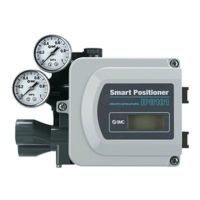- Input current resolution is faulty.
- Check the input current system.
-Actuator’s sliding resistance is
large.
-Reduce the sliding resistance to as
little as possible.
-Operate only the actuator and check
the stick-slip movement. If this
movement cannot be recovered, it’s
beyond the capacity of this
positioner.
-Dead band value is high.
-Change the dead band with the
parameter mode.
-Operation takes time due to the
actuator’s large capacity.
-Wait until the actuator fills with air.
-Contact SMC representatives.
-Actuator is uncalibrated.
-Calibrate the actuator with the
parameter mode.
-PID constant after calibration is
improper due to use of a special
valve.
-Change the PID constant with the
parameter mode.
-There is play in the mounting of
the feed back shaft and actuator.
-Eliminate the play and properly
mount them.
-The input current itself is unstable.
-Check the input current system.
-Ground properly.
-Rotation resistance of the actuator
is significant due to ground and
piston packing.
-Reduce rotation resistance as much
as possible.
-Air is leaking from the piping.
-Check the piping, and stop
the leakage.
-Air is leaking from the positioner.
(due to a seating failure of the pilot
valve. )
-Replace the pilot valve unit.
-Contact SMC representatives.
Automatic calibration
is unavailable
- Fork lever fixing nuts are loose.
-Tighten fixing nuts after fork lever
angle has been adjusted.
-The angle of the fork lever is in
excess of –60/+60 degrees on
both ends of the actuator.
-Refer to “2, fork lever angle
adjustment” in “■Initial Adjustment”,
and securely adjust the angle to
+/-60degrees or less.
-The rotation angle of the actuator
is below 60 degrees or in excess
of 100 degrees.
-The standard positioner stroke is
from 60 to 100 degrees. Use it
within 60 to 100 degrees.

